Bush Medicine of Belize
Central America and the Caribbean
Before modern medicine developed laboratory drugs, our ancestors all over the world used herbs and weeds for health. In many parts of the world today, they are the only treatment available and sometimes work better than manufactured drugs. Many plants exhibit the "Doctrine of Signatures" which is a concept that there is some physical characteristic about a plant that signals what it could be used for on the physical body.
One great example of this concept is the red peeling bark of the Gumbo-Limbo tree. Also called the "Sunburned Tourist Tree" parts of this tree are used to effectively treat poison wood exposure, sunburn, insect bites and most any other skin related problem.
In developed countries many store-bought medicines originate from "Nature's Pharmacy." When you use aloe Vera gel for sunburn, you are benefiting from bush medicine. The active ingredient in aspirin comes from willow bark, a Native American healing plant. Over 25% of the worlds commercial medicines come from plant based chemicals found in the tropical regions. Below are just some of the Natural Remedies found in Belize.
Panti Medicinal Trail
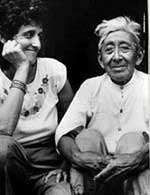
Don Eligio Panti.
During one of their walks in the forest to gather herbs, Don Eligio Panti showed Dr. Rosita all the medicinal plants that were growing along the path. That path has been preserved, and it has become one of the major attractions for tourists who visit the Cayo District.
Visitors to the Ix Chel Tropical Research Center can walk along the trail, which has signs in front of each medicinal tree and plant describing its history and uses. Near the end of the walk, visitors can view a recreation of Don Panti's home. A fee of $5 US is charged for a self guided walk. A guided walk and presentation costs $30, or $50 if given by Dr. Rosita herself.
Terra Nova Medicinal Plant Reserve
In 1993, the Government of Belize established the world's first medicinal plant reserve. This 6,000 acre reserve, dedicated to the preservation of potential lifesaving herbs, is called the Terra Nova Medicinal Plant Reserve. Seedling plants "rescued" from rain forest areas in danger of destruction from development are sent to Terra Nova for transplanting. The reserve is run by the Belize Association of Traditional Healers.
Ix Chel Farms and the Panti Trail is right next door to Chaa Creek. Many tourists get there and back by canoeing along the river. Most Cayo resorts and hotels can arrange a canoe rental and will arrange to pick you up when you dock.
Aloe

Native to Africa, aloe vera is commonly cultivated elsewhere. The clear gel found inside the plant's leaf and the crystalline part found alongside the leaf blade, which contains aloin, are both used for medicinal and cosmetic purposes.
The clear gel is a remarkably effective healer of wounds and burns, speeding up the rate of healing and reducing the risk of infection. The brownish part containing aloin is a strong laxative, useful for short-term constipation. Aloe is present in many cosmetic's formulae because its emollient and scar preventing properties.
Research Results: Aloe Vera juice and extracts have been found effective for a variety of conditions. These include wound healing acceleration in humans, antiviral activities for herpes simplex 1 & 2, treatment of water burns and anesthetic activity for treatment of insect stings in humans.
Annato (Bixa orellana L.)
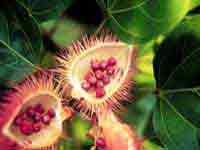
This pink flowering shrub is cultivated for the red/orange dye that comes from it's dried seeds. The seeds are used in cooking to color food such as rice, margarine and soup. They were used by the Caribs and Central American Indians for body paint and insect repellant. Ants that feed off the nectar at the flower base and on the main stem help to protect the plant from harmful creatures. It is used in industrialized nations as a food coloring replacement for red dye #2, which was determined to be a carcinogenic.
Water in which young leaves have been crushed and then strained, has been taken for diarrhea and dysentery.
Research Results: An ethyl alcohol extract of dried Annatto fruit was shown to have in vitro activity against Escherichia coli and Staphylococcus aureus and an ethyl alcohol extract of dried leaves showed the same. Annatto leaves containe favonoids and the seeds contain carotenoids.
Arrowroot
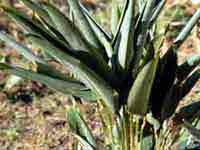
Arrowroot is native to South America and the Caribbean. The local people use its root as a poultice for smallpox sores, and as an infusion for urinary infections. Arrowroot is used as a soothing demulcent and a nutrient of benefit in convalescence and for easing digestion. It helps to relieve acidity, indigestion and colic, and is mildly laxative. It may be applied as an ointment or poultice mixed with some other antiseptic herbs such as comfrey.
Bay Geranium (Ambrosia Hispida)
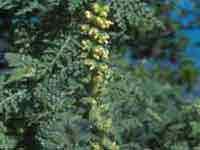
Can be made into soap and used to relieve itching skin. Recommended for indigestion and cleaning of the lungs and mainly used to cure the common cold in the form of a strong tea with lime and salt.
Billy Webb (Acosmium panamensis)

The hard, durable wood of this tree is used in heavy construction, and to make such household items as washing tubs, breadboards and mortar sticks.
The bitter-tasting bark is used as a remedy for coughs and fever. It is the main ingredient in "Sweet Blood", one of the Rain forest Remedies bottled by Ix Chel Farms, which is good for diabetes, dry cough and low appetite.
Blue Flowers (Valerianoides Jamaicensis)

Blue Flowers are used to soothe babies with colic, gas and constipation. Also used to cool the blood and soothe skin irritations in children.
Breadfruit (Artocarpus Altilis)

Breadfruit leaves are used for high blood pressure. The leaves slightly crushed, are also bound on the head and forehead as a cure for headache.
Calabash Tree

It is said that the fruit of the Calabash Tree when roasted is a good treatment for menstrual cramps or to induced childbirth and that the leaf can be used in tea to treat colds, diarrhea, dysentery and headaches.
Research Results: The seed has been effective as an abortive and the fruit pulp to force menses, birth and afterbirth. It is best not to use this plant while pregnant. Consejo.bz recommends against the internal use of the pulp based on toxicity (Robineau 1991)
Candle Bush (Senna alata)
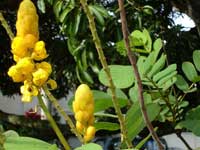
This is a flowering shrub, producing towers of yellow flowers and can be found in yards and disturbed forests. Its Belizean name "Piss A Bed" is derived from its use as a traditional remedy to help urinary tract conditions. Throughout the day, one should sip on three cups of tea made from boiling and steeping the flowers. Drinking a leaf tea can help kidney ailments and liver congestion. Fresh juice from the leaves should be applied to skin diseases such as scabies and ringworm. In Guatemala, its common name is "Ringworm shrub".
Cascarilla (Croton Eluteria)

Cascarilla has a very long history of traditional herbal medicine use worldwide. It has long been used as a digestive aid, to stimulate digestion and digestive juices, for nausea and vomiting, and as a general bitter digestive tonic. The bark is prepared as a decoction and utilized for all types of digestive complaints, feverish conditions, anemia, hemorrhoids and high blood pressure. It is also recommended for diarrhea, dysentery, dyspepsia, intermittent and low fevers, intestinal bloating and gas, colic, nausea, an overall tonic during convalescence, and as an expectorant for chronic bronchitis.
Catnip
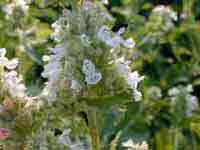
Cats will rub and sometime ingest the plant, and then act "drunk" or "wild" for up to an hour or more. No lasting toxicity is reported. Humans also have their moods uplifted and it is supposed to improve mental clarity and alertness. Aids in pain reduction.
Cat's Claw - Uña de Gato (Uncaria tomentosa and U. guianensis)
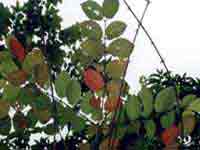
Cat's Claw, also called Uña de Gato, is a thorny liana vine reputed to be a remarkably powerful immune system booster and effective in treating a wide array of maladies. It has been proven to have anti-tumor, anti-inflammatory, and anti-oxidant properties. It has proven useful in treating arthritis, bursitis, allergies and numerous bowel and intestinal disorders. There is some evidence that indicates effectiveness in relieving side effects of chemotherapy.
Cerasee
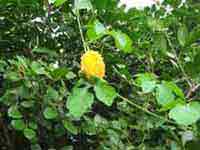
A tea made of the vine is used for diabetes, hypertension, worms, dysentery, malaria and as a general tonic and blood purifier. It is also very effective to relieve constipation and colds and fevers in children.
Women in Latin American use the leaf for menstrual problems to promote discharge after childbirth. The tea is taken for 9 days after giving birth to clean out and tone up all the organs involved in the delivery. Cerasee is also used as a natural method of birth control, by taking two cups each day after intercourse, for three days. It is said that women who drink Cerasee daily will not conceive during that time.
As a wash, the tea is used externally for sores, rashes, skin ulcers and all skin problems. A Cerasee bath is good for arthritis, rheumatism, gout and other similar ailments.
Cockspur (Acacia cornigera)
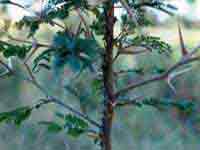
Sometimes called the Bullhorn or Cow Thorn, this plant has a symbiotic relationship with an aggressive and painful species of ant (Pseudomyrmex ferruginea). The ants live in its thorns and protect the tree from encroaching plants, trying to grow near its trunk or leaves high in the canopy. The ants also emerge from the thorns to attack other insects, humans and animals that come in contact with the tree.
The Pseudomyrmex ferruginea ants have been used as a bush medicine for relief of mucous congestion in infants which are given water containing the ants (once they've been squeezed and strained). Snake doctors use the Cockspur bark and root to slow down snake venom from entering the bloodstream. Acne and other skin conditions can be treated by bathing in water in which the thorns have been boiled.
Copal (Protium copal)

This was a sacred tree of the ancient Maya who used the resin as a ceremonial incense, as well as to ward off evil spirits and the evil eye (it is believed that people can harm others by their envious glances).
The resin was once widely used to treat tooth cavities. They would stuff it into the cavity and several days later, the tooth broke and was removed. Bush Doctors will make a powder made from the bark to be applied to wounds, sores and infections. The bark is also used in a tea (taken before each meal), to treat intestinal parasites.
Ginger Root
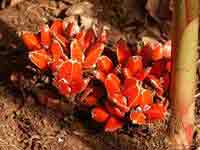
For over two thousand years Chinese Medicine has recommended ginger to treat a number of health problems. The influx of Chinese immigrants to Belize has resulted in the addition of Ginger Root as a bush remedy to combat all forms of nausea and vomiting, including appetite loss, indigestion and motion sickness. Comparisons between ginger and prescription or non-prescription drugs for motion sickness relief have been conducted, and similar effectiveness was seen between ginger and drugs. It is also taken to relieve toothache pain, loosen phlegm, to relieve gas, sore throats, headaches, ulcerative colitis, some types of menstrual pain, arthritis pain, as well as fevers and aches caused by colds and flu.
There are a lot of different varieties of ginger. For a more detailed description of the various plants visit Nature Products Network's great website.
Goat Pepper (Capsicum)
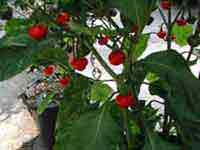
Used internally as a powerful stimulant, being considered beneficial in exciting the appetite, also used externally as a counter-irritant. A leaf is slightly crushed and placed on a boil to "draw" it to a head.
Gumbo Limbo (Kamalamee)
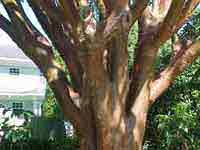
While exploring the Belize, you may see a large tree with red shaggy bark that peels off in paper-thin strips. That's the Gumbo-limbo tree, and its bark is a common topical remedy. Strips of bark are boiled in water and then used topically for skin sores, measles, sunburn, insect bites, and rashes or drunk as tea to treat backaches, urinary tract infections, colds, flu, and fevers. Young leaves rubbed on skin exposed to poison wood can prevent reaction and will sooth itching and speed recovery.
The tree is a member of the same botanical species as frankincense and myrrh, both representatives of the worlds oldest medicines. It is also the source of that very, very soft and light wood used for making toy airplanes and boats. In that form it is called balsa wood.
Note: This tree is also known as the Gamalamee, or Kamalamee tree. It is also called the Sunburned Tourists Tree. Tourists get burned and peel, much like the red peeling bark on this tree. And this tree provides a cure!
Hurricane Weed (phyllanthus amarus)
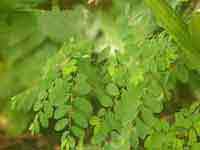
Called both Gale of Wind Weed and Hurricane Weed, the botanical name for this small annual herb is phyllanthus amarus. It is also called the "stone breaker plant" because it has been used for generations to eliminate gallstones or kidney stones. This plant is used for poor appetite, constipation, typhoid fever, flu, and colds. It’s a popular herbal treatment because it has no side effects or toxicity. Phyllanthus amarus has been the focus of a great deal of research in recent years because its antiviral qualities may even be useful in treating hepatitis and the HIV virus.
Jackass Bitters (Neurolaena lobata)
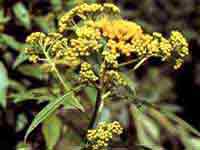
Jackass Bitters is a well-respected plant that has been used widely in traditional Central American medicine. It has yellow flowers and bitter-tasting leaves which contain a potent anti-parasitic agent (sesquiterpene dialdehyde) that is active against amoebas, candida, giardia and intestinal parasites. Traditionally, the herb is taken internally as a tea or a wine or used topically to bath wounds and infections, or as a hair wash to get rid of lice.
Jumbie Plant (wild tamarind)
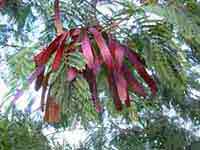
The Jumbie Plant is used mostly to nourish cattle, but is good for human ailments, too. As with most bush medicine, you boil the leaves from the plant and brew into a tea. If you've had a stressful day, a cup or two of the brew will calm you down. If, on the other hand, you're suffering from flatulence, the tea is said to have a calming effect on your stomach. Some folks drink the tea to strengthen their hearts.
Lignum Vitae (guiacum officinale)
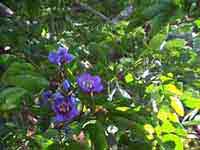
One of the most versatile native trees is the Lignum Vitae, tree of life, or as many old folk call it "Nigly Whitey"). Its glossy leaves are a rich green, and its abundant flowers range in color from purple to blue. Virtually all parts of the tree are valuable, particularly its heavy, dense wood that was once used commercially in construction, until the tree became scarce. Its resin, called guaiacum, is obtained from the wood by distillation and is used to treat weakness and strengthen your back.
Limon Grass
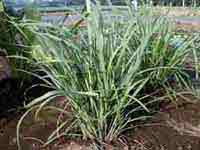
Native from Sri Lanka and South India, lemon grass is now widely cultivated in the tropical areas of America and Asia. Its oil is used as a culinary flavoring, a scent and medicine. Lemon Grass is principally taken as a tea to remedy digestive problems diarrhea and stomach ache. It relaxes the muscles of the stomach and gut, relieves cramping pains and flatulence and is particularly suitable for children. In the Caribbean, lemon grass is primarily regarded as a fever-reducing herb. It is applied externally as a poultice or as diluted essential oil to ease pain and arthritis.
Love Vine
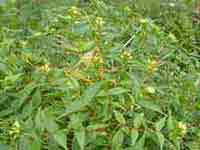
If it is an aphrodisiac you are looking for, then the Love Vine could be the plant for you. Apparently this vine can be found not-so-lovingly attached to other plants, which it eventually kills. As with most of the local remedies, the vine leaves are made into a tea.
Mimosa (Mimosa pudica)

This small ground herb has many common names. It is known in Belize as the Sensitive Plant, Humble Plant, or Sleeping Grass. It closes up and droops down when touched, which indicates one of its properties - to induce sleep. Traditionally, leaves have been placed under one's pillow for treatment of insomnia. A tea made from its leaves and branches is used as a relaxant, pain reliever and to induce sleep. The leaves can also be applied, once mashed, to aching teeth.
Periwinkle
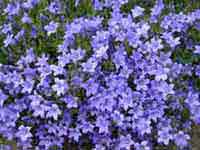
The Periwinkle plant has historically been used throughout the Caribbean to treat a wide assortment of diseases. It was used as a folk remedy for diabetes in the area for centuries. Juice from the leaves is used to treat wasp stings and other insect bites. The plant can be boiled to make a poultice to stop bleeding. It has been used as an astringent, diuretic and cough remedy. In Central and South America, it is used as a homemade cold remedy to ease lung congestion and inflammation and sore throats., an extract from the flowers is used to make a solution to treat eye irritation and infections.
If you've had a hard day at work and have aching limbs, the bruised, boiled leaves of the Periwinkle can be applied, giving much sought-after relief.
Research Results: This is an extremely well steadied plant. It is the source of two potent cancer-fighting alkaloids, Vincristine and Vinblastine. The plant contains alkaloids that ore now crucial in the battle against Hodgkin's disease and childhood leukemia. 72 alkaloids have been isolated form Periwinkle. Interestingly, its effectiveness in the treatment of diabetes, its most common bushmedicinal use, has not been verified.
Picao Preto
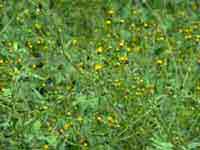
Picao Preto, a small annual herb with prickly leaves and yellow flowers, is considered a weed in many places. But in the Islands, it has a long history of producing herbal curatives, and virtually all parts of the plant are used. The people of Exuma grind the sun-dried leaves with olive oil to make poultices for sores and lacerations. Leaves are balled up and applied to toothaches, or plastered to the head to soothe a headache.
Provision Tree (Pachira aquatica)
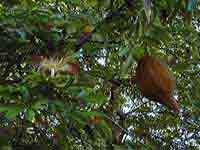
Also known as Malabar Chestnut, Guiana Chestnut and Saba Nut. this tree is sold commercially in the USA under the name Money Tree. It produces large, colorful flowers and fruits. The fruit can weigh up to six lbs, and be a foot in diameter. The seeds can be roasted and eaten.
Provision Tree bark is highly regarded as a blood tonic. A tea made by boiling its bark is used to help anemia, low blood pressure, fatigue and to generally build strength.
Pound-Cake Bush (Parthenium Hysterophorus)
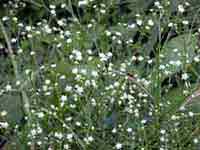
Used to combat "weakness" and is also used for coughs and as a wash for skin sores. The flowers are sometimes "parched" and sprinkled on skin sores. It is also made into a tea for diabetes.
Sarsaparilla

Brought from the New World to Spain in 1563, sarsaparilla was heralded as a cure for syphilis. In Belize, the herb has traditionally been used to treat a variety of skin problems.
Sarsaparilla is anti- inflammatory and cleansing, and can bring relief to skin problems such as eczema, psoriasis and general itchiness, and help treat rheumatism, rheumatoid, arthritis and gout. Sarsaparilla also has a progesterogenic action, making it beneficial in pre-menstrual problems, and menopausal conditions such as debility and depression. In Mexico the root is still frequently consumed for its reputed tonic and aphrodisiac properties. Native Amazonian peoples take sarsaparilla to improve virility and to treat menopausal problems..
Seagrape

Sea Grapes are said to be especially good if you have an upset stomach. Children used to eat them as a sweet treat, but now the most of the local children prefer candy.
Shepherd's Needle (Bidens Pilosa)
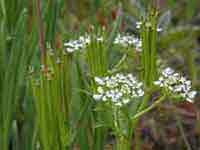
Foliage and flowers are steeped and used for prickly heat, "cooling the blood" and to relieve "sick stomach" and given every day for nine days for worms in children.
Snake Plant (Sansevieria trifasciata)
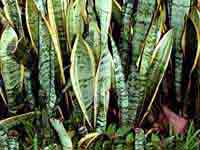
In the Bahamas we called this plant "Mother-In-Law's Tongue" because once it gets started, you can't get rid if it! The color pattern on this stemless plant resembles the skin of a snake. Following the "Doctrine of Signatures" this also indicates one of its uses in bush medicine: For snakebite! Rashes and skin sores can be helped by bathing them with water in which the leaves have been boiled. Some people place leaf juice in water for chickens, which helps prevent diseases. (If you get bitten by a Dangerous Snake in Belize, don't rely on Bush Medicine, get to a clinic immediately!)
Soursop / Guyabano (Annona muricata Linnaeus)

To reduce fever, a tea made from Soursop leaves can be taken internally. Leaves added to bathing water has the same effect. The crushed fresh leaves can be applied on skin eruptions to promote healing. A poultice of young Soursop leaves is applied on the skin to alleviate rheumatism and other skin infections like eczema. The tea has also been used as a wet compress on swollen feet and other inflammations. The juice of the fruit can be taken orally as a remedy for urethritis, haematuria and liver ailments.
Other uses: A thick tea can be used to kill bedbugs and head lice. Mixing pulverizing Soursop seeds with soap & water is an effective spray against caterpillars, armyworms and leafhoppers on plants.
St. John's Wort (Hypericum sp.)
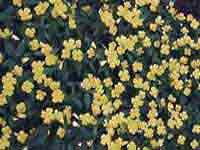
There are several species of this flowering shrub found throughout the world in warm temperate to tropical climates. Our Belizean St. John's Wort is common in the savanna areas and easy to find at The Belize Zoo. It can grow on dry, disturbed soil, and benefits from fire ecology, growing quickly and robust after savanna fires.
Scientific research has found that certain species of St. John's Wort were an effective antidepressant in the treatment of mild and moderate depression.
Wild Yam (Dioscorea villosa)

Wild yam has been used for menstrual cramps and discomfort, rheumatoid arthritis, stomach cramps and pain from gallstones. ailments.
Women in Mexico, for ages, ate the tuber of the Wild Yam as a birth control method. Scientific research has found that the tuber of Dioscorea does contain steroids. These same steroids were then synthetically developed and are used in the manufacturing of birth control pills.
